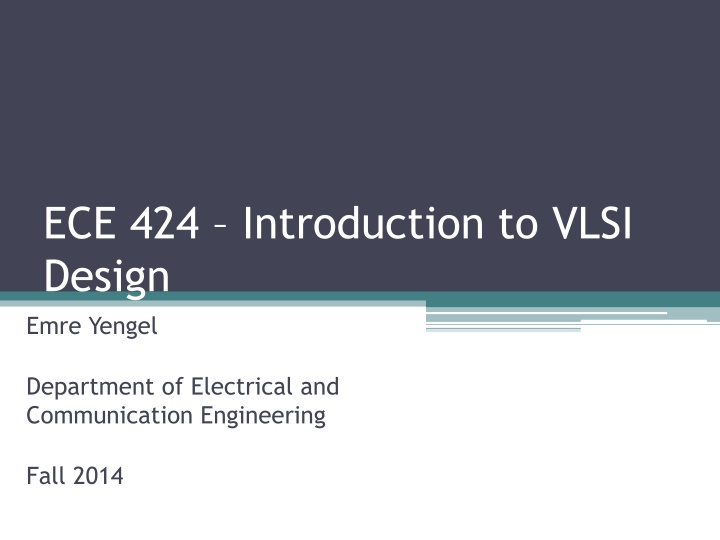VLSI Design Methodologies and Layout Rules: A Comprehensive Overview
This detailed content provides an in-depth exploration of VLSI design methodologies and layout rules, focusing on topics such as standard cell layout methodology, transistor dimensions, design rules for n-well process, and more. The information covers important aspects like minimum widths, spacings, overlaps, and unit transistor specifications for different processes. Additionally, the content includes images illustrating layout techniques and design rules to help beginners get started in VLSI design projects.
Download Presentation

Please find below an Image/Link to download the presentation.
The content on the website is provided AS IS for your information and personal use only. It may not be sold, licensed, or shared on other websites without obtaining consent from the author.If you encounter any issues during the download, it is possible that the publisher has removed the file from their server.
You are allowed to download the files provided on this website for personal or commercial use, subject to the condition that they are used lawfully. All files are the property of their respective owners.
The content on the website is provided AS IS for your information and personal use only. It may not be sold, licensed, or shared on other websites without obtaining consent from the author.
E N D
Presentation Transcript
ECE 424 Introduction to VLSI Design Emre Yengel Department of Electrical and Communication Engineering Fall 2014
Standard Cell Layout Methodology Layout The Design Rules describe: Minimum width to avoid breaks in a line Minimum spacing to avoid shorts between lines Minimum overlap to ensure two layers completely overlap Unit Transistor Transistor dimensions are specified by their W/L ratio For 0.6 m process, W = 1.2 m and L = 0.6 m Such a minimum width contacted transistor is called UNIT TRANSISTOR
Standard Cell Layout Methodology Inverter Layout Transistor dimensions specified as Width / Length Minimum size is 4 /2 , sometimes called 1 unit For 0.6 mm process, W=1.2 m, L=0.6 m
Standard Cell Layout Methodology Inverter Cross section with well and substrate contacts
Standard Cell Layout Methodology Layout A conservative but easy to use Design Rules for n-well process is as follows: Metal and diffusion have minimum width spacing of 4 Contacts are 2 X 2 and must be surrounded by 1 on the layers above and below Polysilicon uses a width of 2 Polysilicon overlaps diffusion by 2 where a transistor is desired and has a spacing of 1 away where no transistor is desired Polysilicon and contacts have a spacing of 3 from other polysilicon or contacts N-well surrounds PMOS transistors by 6 and avoids NMOS transistors by 6
Standard Cell Layout Methodology Rules to get you started; Simplifed based design rules
Standard Cell Layout Methodology 3 Input NAND Standard cell gate layout
Standard Cell Layout Methodology Well Spacing: Wells must surround transistors by 6 Implies 12 between opposite transistor flavors Leaves room for one wire track
Standard Cell Layout Methodology A simple method for finding the optimum gate ordering is the Euler-path method: Simply find a Euler path in the pull-down network graph and a Euler path in the pull-up network graph with the identical ordering of input labels, i.e., find a common Euler path for both graphs. The Euler path is defined as an uninterrupted path that traverses each edge (branch) of the graph exactly once.
Finding an Eulers Path Computer Algorithms: It is relatively easy for a computer to consider all possible arrangements of transistors in search of a suitable Euler path. This is not so easy for the human designer. One Human Algorithm Find a path which passes through all n-transistors exactly once. Express the path in terms of the gate connections. Is it possible to follow a similarly labelled path through the p-transistors? Yes you ve succeeded. No try again (you may like to try a p path first this time)
Finding an Eulers Path Vp x Vertex b c x a Edge Out y c y Vertex a b Gnd
Stick Diagrams Stick Diagrams (SD) VLSI design aims to translate circuit concepts onto silicon. stick diagrams are a means of capturing topography and layer information using simple diagrams. Stick diagrams convey layer information through colour codes (or monochrome encoding). Acts as an interface between symbolic circuit and the actual layout.
Stick Diagrams Stick Diagrams; Does show all components/vias. It shows relative placement of components. Goes one step closer to the layout Helps plan the layout and routing Stick Diagrams Does not show Exact placement of components Transistor sizes Wire lengths, wire widths, tub boundaries. Any other low level details such as parasitics.
Stick Diagrams Metal poly ndiff pdiff Can also draw in shades of gray/line style.






















